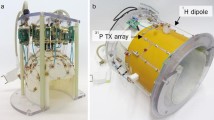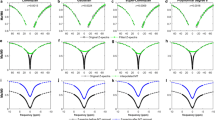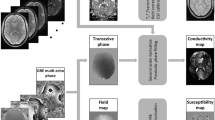Abstract
Object
MR imaging of low-gamma nuclei at the ultrahigh magnetic field of 21.1 T provides a new opportunity for understanding a variety of biological processes. Among these, chlorine and sodium are attracting attention for their involvement in brain function and cancer development.
Materials and methods
MRI of 35Cl and 23Na were performed and relaxation times were measured in vivo in normal rat (n = 3) and in rat with glioma (n = 3) at 21.1 T. The concentrations of both nuclei were evaluated using the center-out back-projection method.
Results
T 1 relaxation curve of chlorine in normal rat head was fitted by bi-exponential function (T 1a = 4.8 ms (0.7) T 1b = 24.4 ± 7 ms (0.3) and compared with sodium (T 1 = 41.4 ms). Free induction decays (FID) of chlorine and sodium in vivo were bi-exponential with similar rapidly decaying components of \( T_{{2{\text{a}}}}^{*} = 0.4 \) ms and \( T_{{2{\text{a}}}}^{*} = 0.53 \) ms, respectively. Effects of small acquisition matrix and bi-exponential FIDs were assessed for quantification of chlorine (33.2 mM) and sodium (44.4 mM) in rat brain.
Conclusion
The study modeled a dramatic effect of the bi-exponential decay on MRI results. The revealed increased chlorine concentration in glioma (~1.5 times) relative to a normal brain correlates with the hypothesis asserting the importance of chlorine for tumor progression.






Similar content being viewed by others
References
Thulborn KR, Lu A, Atkinson IC, Damen F, Villano JL (2009) Quantitative sodium MR imaging and sodium bioscales for the management of brain tumors. Neuroimag Clin N Am 19(4):615–624
Boada FE, LaVerde G, Jungreis C, Nemoto E, Tanase C, Hancu I (2005) Loss of cell ion homeostasis and cell viability in the brain: what sodium MRI can tell us. Curr Top Dev Biol 70:77–101
Ouwerkerk R, Bottomley PA, Solaiyappan M, Spooner AE, Tomaselli GF, Wu KC, Weiss RG (2008) Tissue sodium concentration in myocardial infarction in humans: a quantitative 23Na MR imaging study. Radiology 248(1):88–96
Schepkin VD, Bejarano FC, Morgan T, Gower-Winter S, Ozambela M Jr, Levenson CW (2012) In vivo magnetic resonance imaging of sodium and diffusion in rat glioma at 21.1 T. Magn Reson Med 67(4):1159–1166
Zaaraoui W, Konstandin S, Audoin B, Nagel AM, Rico A, Malikova I, Soulier E, Viout P, Confort-Gouny S, Cozzone PJ, Pelletier J, Schad LR, Ranjeva JP (2012) Distribution of brain sodium accumulation correlates with disability in multiple sclerosis: a cross-sectional 23Na MR imaging study. Radiology 264(3):859–867
Nielles-Vallespin S, Weber MA, Bock M, Bongers A, Speier P, Combs SE, Wohrle J, Lehmann-Horn F, Essig M, Schad LR (2007) 3D radial projection technique with ultrashort echo times for sodium MRI: clinical applications in human brain and skeletal muscle. Magn Reson Med 57(1):74–81
Kirsch S, Augath M, Seiffge D, Schilling L, Schad LR (2010) In vivo chlorine-35, sodium-23 and proton magnetic resonance imaging of the rat brain. NMR Biomed 23(6):592–600
Hoult DI, Richards RE (1976) The signal-to-noise ratio of the nuclear magnetic resonance experiment. J Magn Reson 213(2):329–343
Lu M, Zhang Y, Ugurbil K, Chen W, Zhu XH (2012) In vitro and in vivo studies of (17) O NMR sensitivity at 9.4 and 16.4 T. Magn Reson Med 69(6):1523–1527
Schepkin VD, Brey WW, Gor’kov PL, Grant SC (2010) Initial in vivo rodent sodium and proton MR imaging at 21.1 T. Magn Reson Imaging 28(3):400–407
Haacke EM (1999) Magnetic resonance imaging: physical principles and sequence design. Wiley, New York
Bernstein MA, King KF, Zhou ZJ (2004) Handbook of MRI pulse sequences. Academic Press, Amsterdam
Liang Z-P, Lauterbur PC, IEEE Engineering in Medicine and Biology Society (2000) Principles of magnetic resonance imaging: a signal processing perspective. IEEE Press series in biomedical engineering. SPIE Optical Engineering Press; IEEE Press, Bellingham
Habela CW, Ernest NJ, Swindall AF, Sontheimer H (2009) Chloride accumulation drives volume dynamics underlying cell proliferation and migration. J Neurophysiol 101(2):750–757
Hiraoka K, Miyazaki H, Niisato N, Iwasaki Y, Kawauchi A, Miki T, Marunaka Y (2009) Chloride ion modulates cell proliferation of human androgen-independent prostatic cancer cell. Cell Physiol Biochem 25(4–5):379–388
Civan MM (2010) Transporters beyond transport. Focus on “Deregulation of apoptotic volume decrease and ionic movements in multidrug-resistant tumor cells: role of chloride channels”. Am J Physiol Cell Physiol 298(1):C11–C13
Heimlich G, Cidlowski JA (2006) Selective role of intracellular chloride in the regulation of the intrinsic but not extrinsic pathway of apoptosis in Jurkat T-cells. J Biol Chem 281(4):2232–2241
Sontheimer H (2008) An unexpected role for ion channels in brain tumor metastasis. Exp Biol Med 233(7):779–791
Sartor P, Madec F, Garcia L, Dejean L, Beauvoit B, Dufy B, Rigoulet M (2004) Interactions between intracellular chloride concentrations, intracellular pH and energetic status in rat lactotrope cells in primary culture. Gen Physiol Biophys 23(2):195–208
Poulsen KA, Andersen EC, Hansen CF, Klausen TK, Hougaard C, Lambert IH, Hoffmann EK (2010) Deregulation of apoptotic volume decrease and ionic movements in multidrug-resistant tumor cells: role of chloride channels. Am J Physiol Cell Physiol 298(1):C14–C25
Fu R, Brey WW, Shetty K, Gor’kov P, Saha S, Long JR, Grant SC, Chekmenev EY, Hu J, Gan Z, Sharma M, Zhang F, Logan TM, Bruschweller R, Edison A, Blue A, Dixon IR, Markiewicz WD, Cross TA (2005) Ultra-wide bore 900 MHz high-resolution NMR at the National High Magnetic Field Laboratory. J Magn Reson 177(1):1–8
Qian C, Masad IS, Rosenberg JT, Elumalai M, Brey WW, Grant SC, Gor’kov PL (2012) A volume birdcage coil with an adjustable sliding tuner ring for neuroimaging in high field vertical magnets: ex and in vivo applications at 21.1 T. J Magn Reson 221:110–116
Bull TE, Andrasko J, Chiancone E, Forsen S (1973) Pulsed nuclear magnetic resonance studies on 23 Na, 7 Li and 35 Cl binding to human oxy- and carbon monoxyhaemoglobin. J Mol Biol 73(2):251–259
Christensen JD, Barrere BJ, Boada FE, Vevea JM, Thulborn KR (1996) Quantitative tissue sodium concentration mapping of normal rat brain. Magn Reson Med 36(1):83–89
Erecinska M, Cherian S, Silver IA (2005) Brain development and susceptibility to damage; ion levels and movements. Curr Top Dev Biol 69:139–186
Schepkin VD (2007) Sodium MRI clocks pre-necrotic alterations in rat glioma without changes in tumor diffusion. In: Proceedings of the joint annual meeting ISMRM-ESMRMB, Berlin, Germany, May 19–25, 2007, p 2997
Acknowledgments
Special thanks to Ashley Blue, Richard Desilets, for their valuable help and contribution to the project. The study was supported by National Science Foundation Grant No. DMR-0654118.
Author information
Authors and Affiliations
Corresponding author
Rights and permissions
About this article
Cite this article
Schepkin, V.D., Elumalai, M., Kitchen, J.A. et al. In vivo chlorine and sodium MRI of rat brain at 21.1 T. Magn Reson Mater Phy 27, 63–70 (2014). https://doi.org/10.1007/s10334-013-0387-2
Received:
Revised:
Accepted:
Published:
Issue Date:
DOI: https://doi.org/10.1007/s10334-013-0387-2




